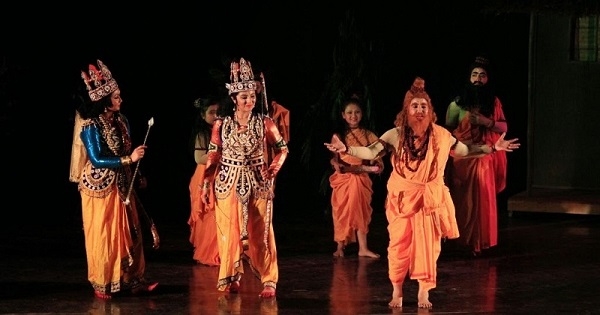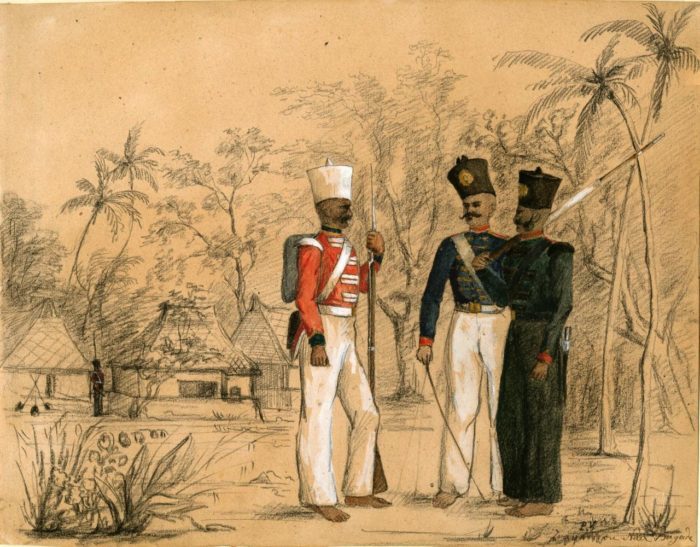- Visitor:93
- Published on: 2025-06-24 05:41 pm
Mallakhamb: Kshatra-Spirited Traditional Yoga Practice
Mallakhamb is known as ‘The mother sport of ancient India’. Mallakhamb is a combination of Yoga, Gymnastics, and Martial Arts. The exercises with poles of mallakhamb and rope are played against the gravity during upward and downward movement. Mallakhamb was originally practiced to develop the strength, agility and flexibility of wrestlers and has now developed into a national-level sport of India.

Bharat, the land of adhyatmikta (loosely translated as spirituality), has always nurtured all – time profound scientific practices aimed at holistic well-being. Although persistent stressing on scientificity traces its roots to western colonial framework— frequently used by leftist ideologues to dismiss our indigenous traditions. But this colonial conspiracy should not blind us to the inherent tark (logic and reason) embedded in our ancient practices. A prime example is Yoga, which is undoubtedly scientific in nature, is largely reduced to mere physical exercise; but in reality, it encompasses a complete philosophy for mental, physical, and spiritual harmony. Sri Aurbindo defines yoga in his series of books ‘Letters on yoga II’ as: “The aim of the Yoga is to open the consciousness to the Divine, to live in the inner consciousness more and more while acting from it on the external life, to bring the inmost psychic into the front and by the power of the psychic to purify and change the being so that it may become ready for transformation and in union with the Divine Knowledge, Will and Love. Secondly, to develop the Yogic consciousness- i.e. to universalise the being on all the planes, become aware of the cosmic being and cos-mic forces and be in union with the Divine on all the planes up to the Overmind. Thirdly, to come into contact with the transcendent Divine, beyond the Overmind, through the supra-mental consciousness, supramentalise the consciousness and the nature and make oneself an instrument for the realisation of the dynamic Divine Truth and its transforming descent into the earth-nature”.
Countless individuals across various yugas have benefitted from Yog. One such powerful tradition is Mallakhamb, which goes beyond physical training, it serves as a means to awaken and revive the Kshatra spirit, the warrior ethos, within the people of Bharat. On 15th June, as we celebrated ‘World Mallakhamb Day’, we must delve into its history and the glory that made this traditional yogic practice renowned worldwide.
Mallakhamb
Mallakhamb is known as ‘The mother sport of ancient India’. Mallakhamb is a combination of Yoga, Gymnastics, and Martial Arts. The exercises with poles of mallakhamb and rope are played against the gravity during upward and downward movement. Mallakhamb was originally practiced to develop the strength, agility and flexibility of wrestlers and has now developed into a national-level sport of India. The word ‘Mallakhamb’ comes from coalescing two words— ‘malla’ meaning wrestler and ‘ khamb’ meaning pole. The gymnast performs aerial yoga postures on a wooden pole, a cane or simply a rope. Traditionally, a wooden pole is used to perform yoga postures, which is made of Sheesham or Indian Rosewood and smoothened by castor oil. Uday Deshpande, a mallakhamb expert said, "Malla as in wrestler, khamb as in pole, evolved as a game, where the pole became the opponent for the wrestler. Mallakhamb’s own name entwines Sanskrit and Hindi to literally mean ‘pole wrestling.’ The climbing, joyfulness, and irreverence of mallakhamb are said to be informed by the spirit of Lord Hanuman, and its strange apparatus reflect his anatomy: the pole is his phallus and the rope is his tail.
History of Mallakhamb
Mallakhamb developed in the state of Maharashtra in India. It was from malla-yuddha, or the indigenous wrestling form, that mallakhamb historically traces its origins in the 12th century. There are many types of Mallakhamb such as Pole, Rope, Hanging, Niradhar (without support), on cane, on floating platform, Mallakhamb with weapons etc. Malla- yuddha, is described in the Mahabharata and then later references to wrestlers exercising on wooden poles occur in the Manasollasa (1135 AD), which is a detailed instruction manual on the scholarship and military training of young Chalukyan princes written by the Chalukya king Somesvara III. In 17th century Shri. Balambhatta Dada Deodhar introduced this game to his pupils and soldiers. He used this sport to enhance the fitness levels of the soldiers and a significant tactic to be used in Guerrilla warfare.
Pole Mallakhamb: A vertical wooden pole is fixed in the ground. The wood used is usually teak wood or sheeshum, preferred because of its twin characteristics of toughness and smoothness.
Hanging Mallakhamb: A smaller version of the fixed mallakhamb, it is suspended with the aid of hooks and chains. The swinging and revolving motion of this type of mallakhamb renders the exercises quite difficult and exacting.
Rope Mallakhamb: A cotton rope which is 2.5 cm thick, replaces the wooden pole. The performers are expected to strike various yogic poses, without knotting the rope in any way.Rope mallakhamb is the form practiced by females but which is also practiced by some men and boys.
The mallakhamb rope is symbolically viewed as the god Hanuman ’s tail. The rope sequences feature the extreme use of flexibility, daring falls and catches. A unique toe grip is employed which is issued for climbing and holding the rope. This is because the sole of the foot is forbidden to touch the rope at any time as this would be considered disrespectful to Hanuman. At the end of the apparatus or “tail” the inner core of the rope is exposed and plaited to actually resemble a monkey’s tail and this is a symbolic visual reference to Hanuman.
Mallakhamb and Fitness
Bhartiya physical exercises transcend the mere realm of sport; they represent a holistic approach to fitness, longevity, and inner balance. Mallakhamb proves to be of immense value in alleviating and even annihilating a wide range of ailments such as insomnia, anemia, chronic body pains, abdominal disorders, kidney troubles, ENT issues, headaches, migraines, chronic bronchitis, chest pain, respiratory or pulmonary problems, rheumatism, and various other hygienic and physiological irregularities. Mallakhamb is a systematic and scientific mode of physical exercise. The controlled and rhythmic breathing and smooth balanced movements help to develop the mental and physical faculties of our body. The arm-holds and the upper hand grips help to develop powerful wrists, strong forearms and muscular biceps and triceps. The clinging grips of the fingers, palms and toes render the nerves and muscles strong and powerful. The acrobatic nature of the feats improves the sense of judgment and the hectic swings, jumps or somersaults promote toughness and fearlessness. By the hanging and swinging actions, neuromuscular coordination is enhanced. The light jerks and jumps gradually tone the lungs and improve the efficiency of the respiratory organs. The forward and backward bends during the display help to accomplish the healthy functioning of the kidney, spleen, liver pancreas and urinary systems. The balancing activities like lifting and resting the body at various angles tone the ligaments of the spine, vertebral column, knees, elbows, ankles, neck and shoulders.
Mallakhamb as a Sport
The First National Gymnastics Championships was held at the Pahadganj Stadium, Delhi, in 1958. The Gymnastic Federation of India proposed to recognize and include the game of mallakhamb in subsequent National Gymnastics Championships. First National Championships of mallakhamb at Gwalior (M.P.) as a part of National Gymnastic Championships. The National Championships of mallakhamb were organized until 1976.
On November 29, 1980 an All -- India Level Association was founded in Ujjain, M.P., later called Mallakhamb Federation of India. Different state associations of mallakhamb affiliated to MFI (Mallakhamb Federation of India) are organizing the national mallakhamb championships in different age groups of Boys, Girls, Men and women. International Mallakhamb Championships are being conducted for the last 5 years in different countries, viz. Argentina, Brazil, Portugal, Spain and Italy and recently, the International Mallakhamb Federation has also been formed. The Asian Mallakhamb Federation was constituted on 1 January, 2011, and its headquarters are situated in Pune, Maharashtra, India.
Mallakhamb stands as a vital yogic practice from the 12th century, designed not merely for physical prowess but to imbibe adhyatmik (spiritual) qualities in Bharatiyas, along with nurturing the Kshattra spirit; the inner strength, courage, and discipline essential to a dharmic life. Rooted deeply in our cultural consciousness, Mallakhamb integrates body, mind, and spirit, transforming the practitioner into a balanced and awakened being. Far beyond a mere physical discipline, it is a path of self-mastery, resilience, and inner awakening, echoing the very essence of Yoga as envisioned by our rishis. As Sri Aurbindo says in his book Synthesis of Yoga: “For the contact of the human and individual consciousness with the divine is the very essence of Yoga. Yoga is the union of that which has become separated in the play of the universe with its own true self, origin and universality. The contact may take place at any point of the complex and intricately organised consciousness which we call our personality. It may be affected in the physical through the body; in the vital through the action of those functionings which determine the state and the experiences of our nervous being; through the mentality, whether by means of the emotional heart, the active will or the understanding mind, or more largely by a general conversion of the mental conscious- ness in all its activities. It may equally be accomplished through a direct awakening to the universal or transcendent Truth and Bliss by the conversion of the central ego in the mind. And according to the point of contact that we choose will be the typeof the Yoga that we practise.”
References
Our history – mallakhambindia.com
Burtt, Jon. “Mallakhamb: an investigation into the Indian physical practice of rope and pole Mallakhamb” International Journal of the Arts in Society, 5 : 3 (2010): 29-38.
SPORT OF MALLAKHAMB: A TRADITIONAL GAME OF INDIAN CULTURE, Dr. Rajkumar Sharma: A research paper
www.mallakhambinusa.org
Mallakhamb: History, Origin and Unique features – www.holidify.com
- 46 min read
- 2
- 0










